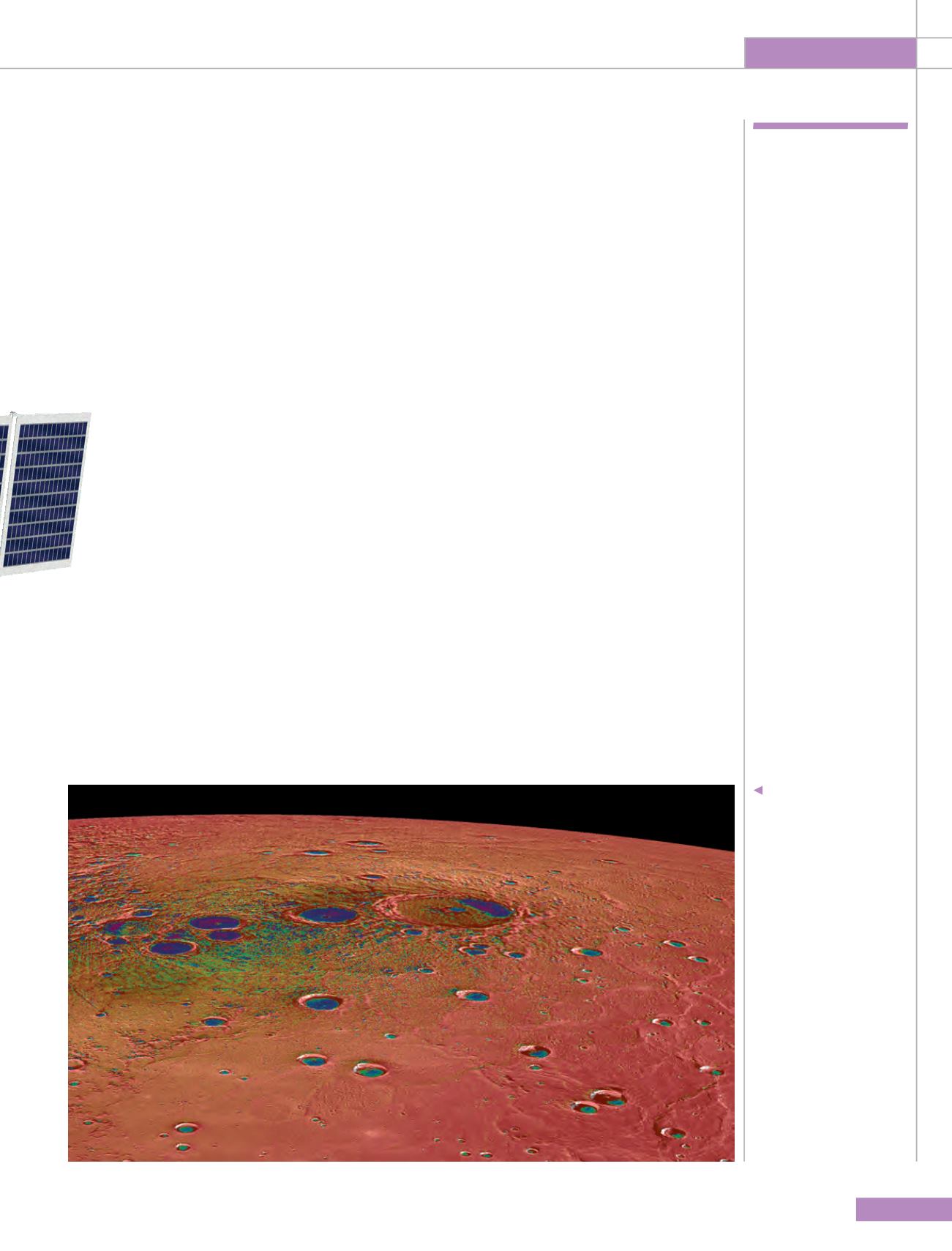
ROOM
85
Space Science
Mercury’s north polar
region, coloured by the
maximum biannual
surface temperature,
which ranges from >400K
(red) to 50K (purple).
Not
surprisingly,
there is a
lot of scope
for scientific
exploration,
however many
technical
challenges
exist in trying
to get a
spacecraft in
orbit around
Mercury
approaching it. Conversely, to be inserted in to
an orbit a spacecraft needs to be slowed down,
therefore a lot of fuel needs to be carried for the
manoeuvres – in fact going to Mercury requires
more fuel than going to Pluto!
Even if engineers were able to stabilise a
Mercury-orbiting spacecraft, you then have to
deal with the intolerable heat coming from the Sun
(about 10 times the solar intensity around Earth).
This naturally has implications for the temperature
at the planet’s surface which, in the case of
Mercury, can reach 400C or more, and depending
on the altitude a spacecraft is orbiting at, Mercury
can reflect and emit as much heat as the Sun itself.
Accordingly, a trip to the inner regions of the
Solar System is not the place to go unless
you’re more than confident in the robustness
of your design.
Mercury’s first visitors
The first spacecraft ever to cautiously approach
Mercury was the NASA probe Mariner 10 and,
ironically, if the mission had gone ahead as
originally planned, many features of the planet
would have remained a mystery.
In the initial proposal that was presented in
1970, Mariner 10 would have flown by Mercury
only once, briefly, after having passed by Venus.
However, an Italian scientist named Giuseppe
Colombo, who at the time was visiting NASA’s
Jet Propulsion Laboratory (JPL), had noticed that
the period of the spacecraft’s orbit around the
Sun, after it flew past Mercury, would be almost
exactly twice the period of the planet itself, so
the spacecraft and the planet would meet again
and, with a little ingenuity, a second fly-by could
be arranged.
JPL looked into Colombo’s idea and found that
by carefully choosing the first Mercury fly-by
point it was actually possible to achieve a second
and even a third fly-by. In 1974-75 Mariner 10 was
able to fly by Mercury three times, photograph
45 percent of its surface and detect its magnetic
field, which at the time was a puzzling discovery
because Mercury was thought to be too small and
rotating to have one.
Mariner 10 remained the only spacecraft to
probe Mercury until the recent MESSENGER
(MErcury Surface, Space ENvironment,
GEochemistry, and Ranging - a reference to
the Roman mythological messenger Mercury).
MESSENGER was the first spacecraft with a single
aim of studying the iron planet.
Launched in August 2004, MESSENGER revealed
the presence of distinct geochemical terrains and
volcanic deposits estimated to be 2.5 to 3.5 km thick
which covered huge basins on the planet’s surface.
MESSENGER also discovered a ‘great valley’ larger
than North America’s Grand Canyon in Mercury’s
southern hemisphere.
At more than 1000 km (620 miles) long, 400 km
(250 miles) wide and 3 km (2 miles) deep, scientists
suggested that the most likely explanation for this
great valley is long-wavelength buckling of the planet’s
outermost shell in response to shrinking or global
contraction – Mercury it seems is getting smaller.
MESSENGER ended its mission in 2015 by
impacting onto the planet’s surface, having
NASA/JPL


